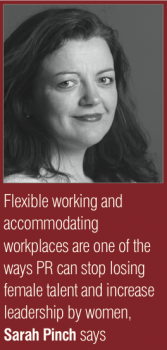
FLEXIBLE WORKING IS NOT JUST FOR WOMEN WITH FAMILIES
“Create an open process to consider flexible working requests, and remember that flexible working is not just for women”
 There is a huge amount of research, often talked about and reported on that makes a clear cut case for balanced, diverse teams; in 2013, McKinsey went so far as to say, “Companies with more women at the top tend to achieve higher organisational and financial performance... What is good for women will also be good for men, and ultimately for the corporation as a whole.”
There is a huge amount of research, often talked about and reported on that makes a clear cut case for balanced, diverse teams; in 2013, McKinsey went so far as to say, “Companies with more women at the top tend to achieve higher organisational and financial performance... What is good for women will also be good for men, and ultimately for the corporation as a whole.”
So why public relations is still the bastion of male leadership, female junior roles – and a whole load of women leaving in the middle – is a mystery to me. And I am embarrassed to say, why is it still one of the whitest, middle class of professions?
I wonder if some of this is down to laziness. Stick with what we know. Not being prepared to do things differently. For those of you who advertise posts, have you ever spent time with an equality advisor to find out where you might place that ad to get the best traction in the BME or LGBT communities?
I have always had mixed teams; in my last role we employed men, women, with children, without, with extra responsibilities at home – and some with none. It was a real mix. And one of the things I remain most proud of is giving my deputy three months off to help settle his child into school (the county in which he lived decided that starting children at school for half days for an entire term was the way to go). The fact that he was the dad, wasn’t here or there in my thinking. But it caused a stir among my fellow executive colleagues. I did not take kindly to it and among all the jokes, made a serious point about keeping an open mind and asking questions of all our staff, about what would make their working life more bearable.
One team member wanted to get in early and leave early. We could manage that for three days out of five. She worked like a trooper. But that was a team decision. Everyone had to be happy. This wasn’t special favour time, it was for commuting reasons.
One team member came back from maternity leave with 15 days holiday stored up – she took one day every Friday for the next three months. It worked for us.
Another colleague was losing her father to cancer; I sent her home on a few occasions – and once rang at the weekend, knowing they were waiting for his test results and suggested she worked from her parent’s house for that week. I also turned down requests. It has to work for the organisation, for the team – as well as being of benefit to an individual.
My top tips are: It is always better to ask than to assume what your team member’s preferences are. Be on the front-foot and make suggestions about what you think might be appropriate with the caveat that they are only suggestions and you are keen to hear what they think.
Second, if someone is going on paternity or maternity leave, be clear on how you will keep in touch – in a recent study of professional women’s return to work experiences, one in three said they hadn’t had enough formal contact with their line manager and other colleagues which may account for half of those respondents saying they hadn’t continued to feel part of the wider organisation.
Last, create an open process to consider flexible working requests, and remember that flexible working is not just for women. And it’s not just part-time, either; it might include term-time working, job-sharing, flexitime, compressed hours, annual hours, working from home on a regular basis, mobile working and/or career breaks.
There is a lot of advice available, including flexible working and maternity guidelines, direct from the CIPR.
Sarah Pinch is president of the CIPR



